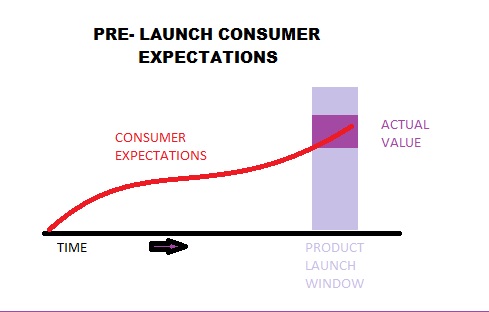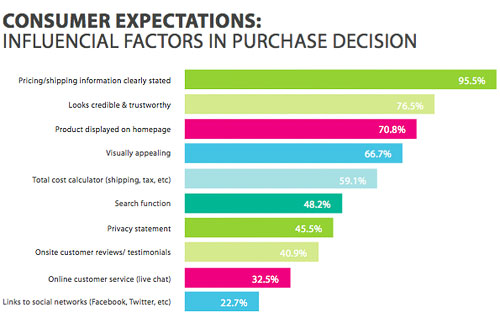Something you cannot get around in marketing is the marketing cycle itself. When people first hear about a product, project, or service, they immediately form an expectation. Up until the time that they make the purchase, all new information they receive about the product in question will affect their expectations. This becomes especially crucial for products that are in a pre-launch sequence.
If you do not hype your product enough, you aren’t going to generate the required enthusiasm to reach the critical mass to make your venture profitable. Over hype your product, and the preliminary buyers will be so disenchanted with their purchase that the whole story will become ‘it didn’t meet my expectations’.
Even if your product is above average or proficient, expectations should be set at a level you can meet (if Facebook stock had hit the market at 29$, it could have easily stayed above that level). It’s a mind game that you play with yourself, the population as a whole, and finally, a roll of the dice when you make your work available to the public and put the results in the hands of the masses.
Give Yourself the Best Chance Possible
Start by getting a domain name that clearly represents your selling points.
You need to have a clear idea of what your sales cycle looks like. Technology is closer to selling a car than it is to selling a candy bar.
The overall value of your product will determine how much negative press you can shoulder. Both Facebook and Google remain industry leaders even after repeated violations of user privacy and charges of questionable value. Both networks have viable competitors, but both also offer superior value to users.

A popular addition to the product cycle that addresses value vs. expectation is Beta testing. In beta testing users agree to help developers refine and polish a piece of software before it is released to the public. Users are conditioned to lower their expectations with the knowledge that the beta release will not measure up to the final product. This process allows developers to gauge perceived value and work to adjust expectations accordingly.
You can guard yourself against over hyping a product by being smart in your marketing prior to beta testing. When the proprietor makes outstanding claims, they lose much of their credibility if the product doesn’t meet high expectations.
In most beta testing scenarios, the early adopters that are selected for testing are more knowledgeable than average users as it pertains to the technology. They’re often more self-reliant, so problems that arise will be less of a burden on the development team. Even if experienced users cannot fix or bypass a problem, they will be able to explain the problem to support staff much easier, and are less likely to let it heavily weigh on their assessment.
Inform Customer Expectations with a Clear Explanation
I can remember developing off base expectations when I was a kid, only to find out that the product or subject wasn’t at all like I had imagined. Everything from Disney World to deep-fried ice cream; nothing ever met my expectations. It wasn’t necessarily falling short of my expectations, just that my preconceived notions were sometimes fanciful and ignorant. It was something I noticed as a child, but it isn’t a feeling I have as an adult.
When acquaintances launch new projects, they often do a poor job in their literature pertaining to what a product does or how it works. It takes a special kind of writing to convey something new to users of every experience level, so take your time and make sure you have the best literature possible before putting anything online.
Understanding the Psychology of Expectation
Dr. Martin Fishbein took expectations a step further in the 1970s. Dr. Fishbein’s theories stated that when making a decision, people relied on the given information to form a belief. Individuals will assign value to each component piece of information that their belief is based on, and expectancy is a calculation that results from the different values placed on each subject.

An example he used was students on the first day of school. Let’s say that your child is preparing to meet two teachers on the first day of school, and one is said to be humorous, but the others is said to be average. The student will develop a positive expectation if they ascribe a positive value to humor. If on the first day of school the student finds that the teacher that is supposed to be humorous is actually average, he will be predisposed to have a negative perception of that teacher, but will wait for further indications before forming an opinion of the teacher that was said to be average. Dr. Fishbein believed that one could accurately calculate the “attitude” of an individual by creating complex equations that assign positive and negative values to beliefs.
The three component parts to Dr. Fishbein’s theory are:
- 1. The Belief that your form in response to all the information you receive about a product before actualization.
- 2. The Value that you place on each pre conceived belief. These can be positive or negative, and can address a wide range of magnitudes.
- 3. Your Attitude is the result of your calculation, which is based on your beliefs and values. After you make a decision about whether your preconceived beliefs are true or not, you will make a complex calculation considering values, your beliefs, and the relationships they create. Your attitude can depend on an unlimited number of value and belief pairs.
If Dr. Fishbein’s theories hold true, you can hypothetically predict the reaction of individuals to your marketing cycle, and adjust their final attitude by altering their beliefs and values. It is important to target the beliefs that hold the most universal value because you can never consider every consumer’s every belief, and you can’t forsee what kind of value each expectation carries.
I think that you can increase your odds, but you can probably get results that are just as accurate by using your own intuition and listening to what users have to say. Either way, a product launch isn’t something that you make up as you go. It should be engineered to give your product the best chance of meeting the highest expectations. If consumers aren’t expecting any value, you will have an extremely hard time reaching the critical mass that it takes to operate as a business. If they’re expecting too much, the lifespan of your product will be all of one day, and the best times your business has will be before you sell anything. You need to set your target as high as you know you can hit.
One Weak Link Can Break Your Value Chain
You may have a superb product, or great marketing, or a flawless distribution plan set up, but any one segment of your business can ruin a customer’s experience. Every department needs to be built up equally because a single weak link in the chain will keep you from supporting the weight of your own hype.

When N-Control launched their Avenger controller in 2011, production and shipping delays put delivery behind schedule for over six months. The problem was that N-Control had already accepted pre-payment for the controllers, and thousands of customers were losing their enthusiasm for the product. The product was well-made, it performed as advertised, and the story of helping handicapped kids play video games was a charming one. The company missed out on millions of dollars in lost revenue because the early adopters (the most important segment in a product’s life cycle) had an expectation that wasn’t met.

Last but not least, do some research and make sure that the value that you place on your product is in line with the value your target market would place on it. Many entrepreneurs go ahead with bad ideas because they convince themselves that it is a moneymaker. After it becomes “Their Thing”, all objectivity is lost and their bias becomes ingrained. Get the opinions of others who do not have a vested interest in your product’s success. Address all the deficiencies in the beginning, and you may be able to transform a bad idea into a viable business.
Now I’ve got a question for you: did the value of this post meet your expectations? Leave your thoughts and experiences in the comments below.
Source(s):
– Fishbein, M., & Ajzen, I. (1975). Belief, attitude, intention, and behavior : an introduction to theory and research
- Blogging Isn’t a Rocket, It’s More Like a Roller Coaster - August 19, 2025
- Value vs. Expectations: The Fight for Startup Survival - July 31, 2025
- The Evolution of Marketing: From Catalogs to Cat Blogs - November 8, 2022
- How to Make a Tweet This Link - February 5, 2022
- Dramatically Improve Marketing Results with Advanced Analytics - September 20, 2021
- The Next Chapter for Social Media Sun - June 4, 2013
- Optimizing Your FAQ to Maximize ROI - December 5, 2012
- Weapons of Influence and Klout’s Role in Marketing - November 17, 2012

You use the word hype. Is that the correct term? Has negative connotations for me.
It can, but ultimately that’s just semantics. To many people any term that is related to marketing, public relations, or even business has negative connotations. Most of the words that you could use i place of hype have negative connotations to one degree or another – promote, plug, advertise.
Just to clarify though, the word Hype (In the context I’ve chosen to use it) is defined as Extensive publicity. Synonyms include advertising, buildup, plugging, promotion. The only listed antonym is Secrecy. To extensively publicize – I cannot think of a more adequate way to describe the build up the precedes a product launch.